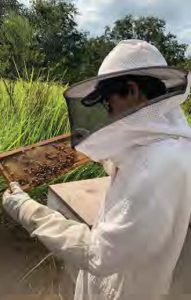By: James Masucci
When I made my decision to focus on bees, I had several concerns. How big do I want my business to be? Where am I going to put all the bees? What equipment do I need? Where am I going to store it? My career was as a scientist, not a businessperson. Over the past six months, however, things have started to fall into place. What I realize is that it is not just me who is responsible for my success, I owe a lot to people who have helped me along the way. Beekeepers think of beekeeping as a solitary experience. Just us and our little flying friends sharing some time together. But the reality for me is that my success is dependent on a lot of people and the relationships I’ve developed with them.

My future bee truck, thanks to my son-in-law and Osage Ambulance.
First and foremost are the landowners. I now have more than a dozen yards and I don’t own the property of any of them. Commercial beekeepers know this well and a good beeyard is more precious than gold. All they ask for is some honey, that I respect their land, and that I keep them updated. The ripple effect of my land-owner relationships has gone far beyond a place to put my hives. They’ve led to new yards, markets, and storage locations.

A perfect place for my stuff! Thanks to one of my landowners.
I have one yard at a small, all-natural vegetable farm. This is my only yard I got by knocking on someone’s door. The family was just starting the farm and I was just starting with my bees, so we both hit it off. They have become successful, selling at farmer’s markets and restaurants. Not only have we developed a friendship, but we work together. He sells my honey both at the farmer markets and to restaurants. A mutual benefit for both of us. He recently gave my number to a woman whose father-in-law was having trouble keeping bees. She called and we talked for a while about the various issues with keeping bees. During the conversation, she asked if I’d be interested in putting bees on her property. I went to visit, we toured the place and found a great site. We chatted for about an hour. As I was leaving, she told me she owns another four acres surrounded by fields . . . if I was interested. Of course, I was interested! Two new beeyards because I was willing to help someone out.
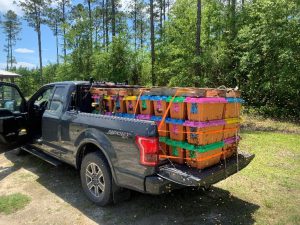
Forty-eight in the back and one in the front went from Southern GA to St. Louis. Thanks to Barry Hart who put them together for me.
In my last article, I talked about needing a bee truck and a place to put it. My son-in-law recently came through for the bee truck. He is a firefighter/paramedic who also sells ambulances. He found me a used ambulance chassis (see picture) that I’m in the process of outfitting with a flatbed and lift-gate (I have a smile on my face just writing about it). However, I can’t park an F450 flatbed in my suburban neighborhood! I went looking for property (still am) and I found an old gas station in a great location for my bee operation. I talked to one of my land-owner friends to find out the owner. The guy didn’t want to sell. However, my land-owner friend said, “you know, you can have a corner of my barn if you would like.” I went to see it a couple of days ago (see picture). It’s perfect. When I told him that he chuckled and said, “well, the price just went up” (it didn’t). Now I have a home base to store equipment, supplies, AND my truck. It buys me time to find the property I really want to buy.
The landowners aren’t the only people I depend on. My personal beekeeping community, consisting of both commercial beekeepers around the country and local hobbyists, are constantly supporting my activities. After having the worst winter survival of my career by far, I called a friend of mine in GA who sold me a truck load of bees (the joke here is that for him, a truck load is a semi-load. I just filled up my pick-up (see picture)). These bees allowed me to expand into new areas without disrupting my sales of local nucs. Locally, we beekeepers provide each other with resources we need to get through emergencies. We help each other finding markets and point our customers to each other when we can’t fill a need. Probably more importantly, we share information and troubleshoot each other’s problems. It’s become obvious to me that though I may work my bees alone, the list of people who help me in this endeavor is large, and I’ll be forever grateful for their support in helping me succeed.
Click here to go directly to Part 3 – Where Do I Put It?
Click here to go directly to Part 5 – A Place for My Honey House
]]>Should I apologize?
Should I immediately apologize for spending your reading time on an antiquated subject like “tanging” while other writers – in this very publication – are properly writing informative and current pieces for your beekeeping edification? In my defense, my involvement in this legacy swarm management topic started innocently enough and, ironically, some of my beekeeper friends caused it. In a real way, this saga is not my fault.
A wearying zoom presentation
Last April, I presented a zoom talk on swarms and swarm biology to the Broward County Bee Club in Florida – an energetic and organized group. I thank you for inviting me. Though the group was engaged and supportive, it has been my sense that, after a short time, most Zoom talks have a numbing effect on the brains of both the listeners and the presenter. Try as I might, as the Broward session went to Q&A, I had the typical unfulfilled sense that somehow, I had not done my job as a presenter, and I just hate that feeling.
Though the group was engaged and supportive, it has been my sense that, after a short time, most Zoom talks have a numbing effect on the brains of both the listeners and the presenter. Try as I might, as the Broward session went to Q&A, I had the typical unfulfilled sense that somehow, I had not done my job as a presenter, and I just hate that feeling.
I don’t remember who did it…
Since the topic had been on honey bee reproductive swarming, and since we had previously discussed the frustration of losing a swarm, either I or someone else mentioned “tanging” a swarm before it escaped. It’s an old recommendation to tang the swarm to get it to settle.
Several participants had no opinion, but several did have strong beliefs that tanging did work – and it worked dependably. I admitted to the group that night, as I admit to you readers now, that I have no technical information that could explain how this old process works or why it would work. At the time, I was caught unawares and after thinking for a few days, I convinced Kim Flottum that we should use one of our podcast segments at Honey Bee Obscura to discuss the swarm concept of tanging.
The results of our tanging podcast were much like the earlier experience I had in Florida. Beekeepers who believe in tanging, devoutly believe in it. We had follow-up communication with experienced beekeepers who wanted to be on record as being “tangers.” They tang and they recommend it.
A primer on tanging a swarm
In today’s language, a simple definition of the process would be a swarm is tanged when noise – usually made with metal pieces such as a metal pan being struck with a metal spoon – is produced near the moving swarm. It is generally thought that a swarm cannot be prevented by tanging, but it can be convinced to “pitch” (or land) at a nearby location. Believers feel that the tanged swarm will come down – or at least – will usually come down. No one has said to me that all swarms come down all the time. On the other hand, unbelievers feel that nothing is changed by implementing the noise-making process, and that the swarm either lands – or not – on its own.
Here’s the enduring tanging quirk – there have been believers and unbelievers for hundreds and hundreds of years. Yet, this concept has clearly not passed into history. It perseveres. Does this process work or not?
The Hive and the Honey Bee and ABC & XYZ of Beekeeping
The two hallmark books of U.S. beekeeping, The Hive and Honey Bee and ABC and XYZ of Beekeeping have insightful input (or not). So far as I could find, the current Hive and the Honey Bee makes no mention of the procedure – at all. If the procedure was invaluable in its deployment, and established in beekeeping lore, would not this respected book have contained detailed information?
Authors of the ABC and XYZ of Beekeeping, wrote, “There is no evidence that tanging has any effect on swarm behavior, although some beekeepers still believe that it does.” As is the usual case, the ABC & XYZ author presented the justification for tanging a swarm was to keep it in sight and retain ownership of the mobile swarm as it crossed property lines.
Nearly 400 years ago
In 1623, Charles Butler wrote “The Feminine Monarchie: or The Historie of Bees. In chapter five of his book, he discussed tinging the swarm. He did not use the more recent term, tanging. Still other authors, eons ago, used the word tinkling in lieu of tanging or tinging.
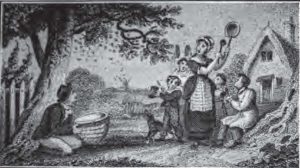
Engraving of a swarm tanging event. nearly 200 years old.
As best I can translate Old English to English, beginning at the third paragraph of Butler’s work, in the reproduction that I have presented in this article, he wrote the following description:
When the swarm is up, and busy in their dance, it is a common way, for want of other music, to play them a fit of mirth with a pan, kettle, basin, candlestick, or other like instrument, for to stay them, forsooth, from flying away. Indeed, where other bee-folds are not far off, this way hath a good way: for thereby, the place and time of their rising is publicly noted, and for a clear and open claim laid unto the swarm that otherwise some neighbor might challenge for him, which undoubtedly was the original cause of this custom. But the pretended reason is to me a mere fancy: but I know it to be as ancient as common. (At this point, Butler includes several comments made by much earlier scholars and writers – all relating to tanging and in other languages. In fact, in other publications, references are made to Columella describing tanging 500 B.C. Pliny (AD 23-79), Virgil (BC 70-19), and Claudian (c. 370-404) instructed swarm chasers to “strike brazen vessels.” (This process of striking metal vessels to bring down a swarm is clearly a very, very old swarm-gathering recommendation.)
Butler continued: If you see them begin to fly aloft, which is a token that they would be gone, cast dust among them to make them come down. If they cannot be stayed, hastening on still, go beyond your bounds, the ancient laws of Christendom permits you to pursue them, where to fore, for the recovery of your own. Notwithstanding, do what you can, sometimes they will away, and perhaps fly too far before they settle, that though follow them never so fast, you must be content to leave them happily to the happy finder. For when you have lost the sight and hearing of them, you have lost all right and property in them (JTew bolding).
Yet another older literature review on tanging
Harrod-Hempsall1 published a thorough discussion of tanging in volume one of his two-volume beekeeping tome, Bee-Keeping, New and Old. He cited John Keys2 who, in his earlier 1814 book, Treatise on Breeding and Management of Bees, gave explicit support to “tinkling” bees and offered several specific recommendations that I present below.
“If prime swarms, were not in the habit of settling in a usual spot, would most likely be lost by the “apiator” if not tinkled.”
Secondly, “For prime swarms (first swarms), the noise should not begin till such a quantity of bees have arisen as will for a good swarm, for fear of terrifying the princess (JTew comment: the queen) from issuing; and if so, all the bees will return, though hived.”
Thirdly, “The noise should be made on the contrary side to that which will be most proper for settling.” (JTew comment. Essentially, tang on the opposite side of the swarm at the site where you would like them to settle.)
Fourth, “Nor should it (tanging) continue longer than the bees begin to cluster; there is no danger, but the rest will follow on hearing their buzz.”
Fifth, “The greater the noise, the sooner it (JTew comment: tanging) is likely to succeed. I find a watch rattle (used about London) the most efficacious, and that when the common method has failed.”
A watch rattle is a noise ratchet. It was used by British and later, also used by US police, as a noise maker for attracting both attention and other police persons. It now has musical uses or sound effect uses. Also, I have seen children’s’ toys that were similar rachet devices. The watch rattle is nicely explained and shown at: https://www.youtube.com/watch?v=BViVjh9mTeU.
Harrod-Hempsall wrote that the during the last century, it was felt that an iron frying pan and door key were the most efficacious tanging instruments. Obvious, this was the large, heavy keys much like the ones that always hang on the wall in jails in old western movies, and not the little flimsy key that I have in my pocket at this very moment.
Harrod-Hempsall wrote that John Keys presented very full instruction, “but they contain the only valid reason for tanging, viz., as a means of claiming the swarm.”
The swarm, the law, and polite society
What if you saw a swarm issue from your colony and settle on your neighbor’s property? Then, what if, you watched that neighbor put what had been your bees in a hive box of his? What would you feel? Rest assured that such feelings were long ago experienced by others. As is so often the case, the law has a long history of involvement in determining, “who owns the transient swarm?”

Tanging description from Butler’s 400-year-old book.
I am in no way qualified to write about legal ramifications, so I cite some dated (and tedious) material from Harrod-Hempsall on this subject. At the time, British law was based on Roman law. Roman law designated honey bees as ferae naturae – being of a wild nature – and were res nullius or belonging to no one. So, let’s say that I hive a swarm, ferae naturae, and I confine it (so much as possible), so they do not escape and reclaim their natural liberty. If they abscond or swarm again, and regain their natural liberty, my ownership of the swarm immediately ceases.
Readers, at this point, things really become contorted. Apparently, a summary of the situation could be that I have wild animals (bees) in a box on my property. They swarm, and I see them go. I make noise to alert others. The bees are mine so long as I can keep them in sight and so long as others confirm that the bees were mine. Maybe the bees, which I have kept in sight, land on a tree not on my property. Though they continue to be my bees, I am not free to trespass at will. Essentially, my wild animals are near to regaining their natural liberty, but by doing so, the ownership of the bees is now ratione soli (by reason of the soil). The person who owns the soil on which the tree stands becomes entitled to the bees. From above, I cite Butler again, “For when you have lost the sight and hearing of them, you have lost all right and property in them.” If they have been kept in sight, a claim of ownership could be justified. As it were, the bees have simply temporarily gone astray.
Harrod-Hempsall wrote, “When an action is fought, much depends on the attitude of the Judge with regard to defining the law, circumstances vary, and points which are debatable crop up.” He finished his comments by admonishing the reader that it was better to sacrifice the swarm than to go to the law.
My reason for putting you through this discussion.
The legal issues surrounding lost swarms and ownership, in years past, were complex and complicated. Bee skeps were common and provided essential components for life. Swarms were coveted both then and now. Indeed, swarms were valuable enough to hire either the very young or the very old to watch for issuing swarms.
When the swarm did finally issue, noise was made to alert the community that bees were on the move and to maintain visual record of the bees in order to defend ownership when landing on the property of others. Though I have never read this, I know that the noise would also alert others to help watch for the directional movement of the swarm – or worse – alert others to deviously try to capture the swarm.

Butler telling the reader, when you have lost sight and sound, you have lost all rights to the swarm.
Don’t blame the messenger
Herrod-Hempsall bluntly wrote, “The noise made by tanging has no effect whatever upon swarming bees, therefore, instead of wasting time and annoying neighbors by making an abominable din, advantage should be taken of the known habits of bees.”
Some good news
Realizing that after hundreds and hundreds of years, no one’s current mindset has been changed on this subject by my comments, I can confidently say that tanging a swarm does no harm. In the excitement of the swarm meandering along, at least it is something to the “apiator” can do while the swarm is in motion.
Whether or not tanging works, when beekeepers use noise to entice a swarm to settle, they are employing an ancient method that has been passed through many generations of earlier beekeepers. At that swarming moment, you are feeling what so many other now departed beekeepers have felt. You are “in the moment.” Feel free to tang. At least you are doing something.
Dr. James E. Tew, Emeritus Faculty, Entomology, The Ohio State University and, One Tew Bee, LLC; [email protected]; http://www.onetew.com

With this method, even beekeepers who have difficulties with grafting due to failing eyesight or other reasons can breed queens. It is based on the “Cell punch method” described by the late English beekeeper David Cushman.
Material
– one 2 ml disposable syringe per cell (a box of 100 costs less than five euros on the Internet. If you only need a few syringes, you can also get them at a pharmacy. Or ask your dentist or family doctor.)
– Express clamps 7-12 mm, for example from the hardware store
– a sponge cloth
– a sharp knife.
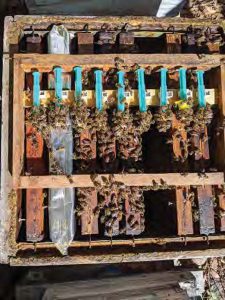
The steps of procedure
1.Pull out the plunger completely from the syringe and cut off the two ends of the syringe barrel with the knife.
2. Prepare your breeding frame by placing a crossbar in one frame and attaching the express clamps to it (see large picture above). If you want to cage the queen cells, you can drill a hole in a queen cell cup according to the outer diameter of the syringes and attach them to the syringe barrel with wax or superglue.
3. At the given time, remove a comb with open brood from the colony from which you wish to graft eggs and sweep off the bees. Then look for young larvae, which should be in the largest possible amount of royal jelly. Place the moistened sponge cloth on a flat surface and the comb on top of it. The area from which you want to punch out the cells should be above the sponge cloth. It prevents the wax from sticking to the table when punching out a cell. Pay attention to the wires so that you do not hit one.
4. Hold the syringe barrel so that the two rings visible inside are at the top and punch out the cells you have selected using circular movements. You must press until the cylinder hits the sponge cloth. Then pull the syringe cylinder out of the comb again, leaving the punched-out cell in the cylinder.
5. Then insert the syringe plunger on the side of the syringe where the punched-out piece of comb is located. Push the piece through the cylinder until the plunger is stopped by the lower ring in the syringe.
6. Make three vertical incisions in the walls of the cell with the knife, fold the cell walls down, and press them onto the outer surface of the syringe barrel.
7. Then insert the syringes with the cells into the clamps of the breeding frame. Afterwards put it either in an incubator or in a nursing colony. The acceptance rate by the bees is normally quite high.
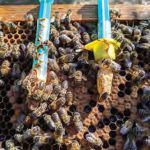
Additional tips
Practice punching out first on old combs that you want to melt down anyway, or on drone combs. I recommend that you process all the cells you need up to step 4, then put the frame with the breeding material back in the colony and only then continue with steps 5 to 7. By the way, the holes created by the punching are rarely closed again by the bees.
If you give a syringe with a nursed queen cell into a hopelessly queenless colony 36 hours after punching out the cell, you don’t need to cage the cell and the queen will hatch in the colony. The syringe can be hung between two frames.
Summary
The method is much easier in practice than the description might suggest at first. Since I need only a few queens, it is ideal for me. In contrast to grafting, it can be done anywhere, even if the conditions are not optimal. Try it and you will see, it is really quite simple!
The advantages of the method
– The larvae remain in their natural cells.
– The queen does not have to be found in the colony.
– The cost of materials is very low.
– With a little practice, the cells are punched out very quickly, and the comb can be hung back in its colony after a short time.
– The syringes with the queen cells can be easily removed and placed between two frames.
– Reprinted with permission from Deutsches Bienen Journal
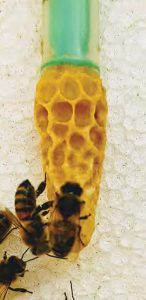
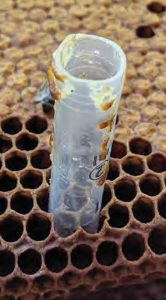
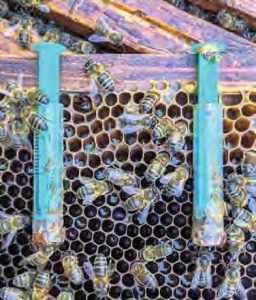
]]>
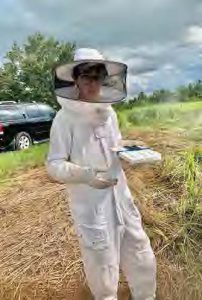
Manaswi can eloquently expound on how bees pollinate 80% of global crop supply and how important bees are to Earth’s ecosystems and biodiversity. “Bees are dying across the globe, and more attention needs to be drawn towards this crisis. We can’t afford to lose them,” he explains.
Captivated by honey bees, Atreya attended the South Florida Bee College where he met Dr. Jamie Ellis, a Professor at the University of Florida Honey Bee Research and Extension Laboratory who specializes in honey bee husbandry, ecology, and conservation.
Atreya conducted his first-year project on bee nutrition where he ran a choice-test on popular commercial protein (pollen) supplements to help commercial beekeepers determine a suitable replacement in times of pollen unavailability. His findings indicated that AP23 is the most preferred protein supplement brand for honey bees.
For his second-year project, he decided to tackle a devastating predator of the honey bee, the small hive beetle. Discovered in the U.S. only two decades ago, this pest species continues to spread across the globe. “One female hive beetle can deposit over 1000 to 2000 eggs upwards in a single lifetime,” notes Manaswi. Beetles wreak havoc once inside the hive and can destroy a colony in just a week’s time.
In his research, Manaswi tested organic agents to discover a new, affordable, and safe alternative to the current treatment options. The most common, EPA-approved chemical for in-hive treatment is coumaphos (organophosphate) that is sold in the form of CheckMite+ strips. Studies have shown that this compound is deadly to honey bees in certain exposure scenarios. Moreover, research has also confirmed chemical residues in beeswax, honey, propolis, and other hive products.
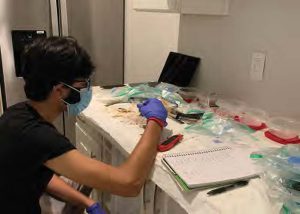
Well, this year, I actually couldn’t gain lab access due to the COVID-19 crisis, so I had to be creative. Using some household items I made a mini “home-lab” in my mother’s kitchen (though, she wasn’t too eager about it). This is where I did all my treatment formulation, beetle collections, and analysis.
In his experimentation, Atreya tested eight agents in beetle traps: apple cider vinegar with mineral oil (the natural currently used treatment), mango puree with boric acid, cantaloupe puree with boric acid, yeast, peanut oil, grapeseed oil, beer, and a control which had no treatment. Manaswi chose these agents because of their attractive odor compounds. The test was set up to determine which agent is most attractive to beetles in hive traps.
Through extensive testing and rigorous analysis, he discovered that beer was a clear winner. He concluded that beer was 33 times more effective for beetle treatment than apple cider vinegar. Manaswi claims his treatment is environmentally friendly and poses no adverse health risks to humans, wildlife populations, or bees. Beer provides cost benefits over the current chemical options, as well. It costs merely two cents for hive maintenance and a 12 pack of beer for five dollars is enough to treat over 215 whole hives.
Kenneth Griner, a Central Florida beekeeper, was extremely encouraging of Atreya’s research. “Mr. Griner was amiable and understanding. I was privileged to work with him. He even allowed me to run tests on 24 whole beehives! That’s over 1.2 million bees!” exclaimed Atreya.
Dr. Charles Stuhl, Ph.D., a Research Scientist at the USDA-ARS, Center for Medical and Veterinary Entomology, Gainesville, Florida mentored Atreya on his second-year project. “He educated me on how fatal hive beetles can be to a colony and informed me more about this ongoing global crisis,” stated Manaswi. Being a middle schooler, Atreya learned from Dr. Stuhl about academic research and how to present findings in a public setting.
Atreya soon came to realize the struggles of field work. “Last year, working in a lab, I was not exposed to the difficulties and harsh reality that beekeepers face daily. The heat and working conditions in the field were unbearable at times. Beekeepers are truly our unsung superheroes. And, during times of crisis, it’s even more important to appreciate the effort it takes for food to reach our dinner tables. Beekeepers and other agricultural workers alike toil endlessly to ensure we get food,” Manaswi affirms.
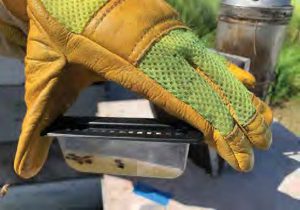
COVID-19 had a significant impact on Manaswi’s research. “It certainly did serve as a roadblock, but it taught me a lot. I had to be creative and find common household items to serve as lab tools for my work. I used items like aprons, scissors, paper towels, plastic bags, and even Tupperware. Because of the pandemic, I had to count beetles in my kitchen! My mother wasn’t all that eager about that idea, though!” he states. “Admittedly, there were countless instances when the beetles would go loose. My family and I would play tag, darting around the house with tiny fish nets in hand!”
Manaswi entered his research into the State Science and Engineering Fair of Florida. He was selected as the 1st place winner in the Animal Science category. Atreya was also presented the “Best in Fair” Grand Award for the Biological Sciences. Additionally, Manaswi was awarded other accolades for his work.
Although very appreciative, Atreya remarks, “the biggest prize for me is knowing that I am involved in something that could help save our bees.” Food is such a precious commodity and more than 80% of all plants are pollinated by bees. If these plants cease to exist, biodiversity, ecosystems, and the food chain would collapse. Manaswi states, “Bees are the key to stability on our planet. My greatest satisfaction lies in knowing that I am contributing towards their conservation.” He hopes to further his study of the honey bees in the future.
A youth researcher at heart, he believes everyone has the power to discover and learn. “Most kids find research boring or dull, but it’s really quite the opposite. I have fallen in love with the essence of learning about the unknown and exploring what our world has to offer,” Manaswi expresses, “I have come to understand the power of research and how, even as a kid, I can research ways to make life sustainable on our planet. I would tell anyone who wants to try something new to just look in their community and find the solution to an ongoing problem.”
